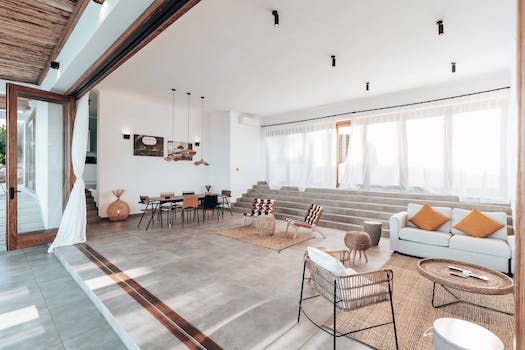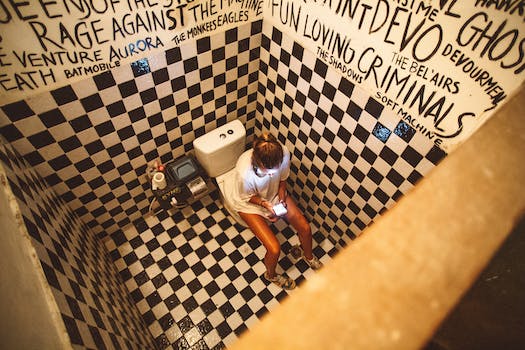

-
Table of Contents
The Modern Open Office: A Panopticon Perspective - Redefining Workplace Transparency.
Introduction
The modern open office has become a popular workplace design in recent years, aiming to foster collaboration and communication among employees. However, this layout has also raised concerns about privacy and surveillance. This article explores the concept of the modern open office from a panopticon perspective, examining the potential implications of constant observation and the loss of personal space in the workplace.
The Impact of Surveillance in the Modern Open Office
The modern open office has become a ubiquitous feature of the corporate world. With its sleek design, collaborative spaces, and flexible workstations, it is often hailed as a symbol of innovation and productivity. However, beneath its shiny exterior lies a darker reality – the impact of surveillance in the modern open office.
Surveillance in the workplace is not a new concept. For decades, employers have used various methods to monitor their employees, from time clocks to security cameras. However, the open office takes surveillance to a whole new level. With its lack of walls and barriers, employees are constantly under the watchful eye of their colleagues and superiors.
One of the most obvious forms of surveillance in the modern open office is the presence of security cameras. These cameras are strategically placed throughout the office, capturing every move and interaction. While their primary purpose is to deter theft and ensure the safety of employees, they also serve as a constant reminder that someone is always watching.
But it's not just the cameras that contribute to the panopticon effect in the open office. The layout itself plays a significant role in creating a sense of constant surveillance. With no walls or cubicles to provide privacy, employees are constantly exposed to the gaze of their coworkers. This constant visibility can lead to self-consciousness and a feeling of being constantly judged.
Furthermore, the open office often promotes a culture of transparency and collaboration. While these are undoubtedly valuable qualities in a modern workplace, they can also contribute to a sense of surveillance. In an environment where everyone can see and hear what you are doing, it becomes difficult to escape the feeling of being constantly monitored.
The impact of surveillance in the modern open office goes beyond mere discomfort. Studies have shown that constant surveillance can lead to increased stress levels and decreased job satisfaction. Employees may feel pressured to constantly perform and be on their best behavior, leading to burnout and a decline in productivity.
Additionally, the lack of privacy in the open office can have a detrimental effect on creativity and innovation. Research has shown that individuals need a certain level of solitude and privacy to generate new ideas and think critically. In an environment where every move is scrutinized, employees may be hesitant to take risks or share their thoughts openly.
So, what can be done to mitigate the negative impact of surveillance in the modern open office? One possible solution is to create designated private spaces within the open office. These spaces can be used for confidential meetings, quiet work, or simply as a refuge from the constant gaze of others. By providing employees with the option to retreat from the open environment, employers can help alleviate some of the stress and pressure associated with constant surveillance.
Another solution is to foster a culture of trust and autonomy. When employees feel trusted and empowered to make their own decisions, they are less likely to feel the need for constant surveillance. By focusing on results rather than micromanagement, employers can create a more positive and productive work environment.
In conclusion, the modern open office may be aesthetically pleasing and promote collaboration, but it also comes with a hidden cost – the impact of surveillance. From security cameras to constant visibility, employees in the open office are under constant scrutiny. This can lead to increased stress, decreased job satisfaction, and a decline in creativity. However, by creating designated private spaces and fostering a culture of trust, employers can help mitigate the negative effects of surveillance in the modern open office.
Balancing Privacy and Collaboration in the Open Office Environment

The modern open office has become a popular trend in recent years, with many companies embracing the concept of a collaborative and transparent workspace. However, this shift towards open office environments has raised concerns about privacy and the potential for constant surveillance. This article will explore the concept of the modern open office from a panopticon perspective, examining the balance between privacy and collaboration in this type of workspace.
The panopticon, a concept developed by philosopher Jeremy Bentham in the late 18th century, is a prison design that allows for constant surveillance of inmates. The central idea behind the panopticon is that the mere possibility of being watched at any given moment creates a sense of discipline and control. In the context of the modern open office, the panopticon perspective suggests that the constant visibility and lack of privacy can have similar effects on employees.
One of the main arguments in favor of the open office is that it promotes collaboration and communication among employees. The absence of physical barriers, such as cubicles or closed offices, is believed to foster a sense of community and teamwork. However, this constant exposure to others can also lead to distractions and a lack of focus. Without the ability to retreat to a private space, employees may find it difficult to concentrate on their work or have confidential conversations.
Furthermore, the lack of privacy in the open office can have negative effects on employee well-being. Research has shown that constant exposure to others can increase stress levels and decrease job satisfaction. The feeling of constantly being watched can create a sense of anxiety and self-consciousness, leading to decreased productivity and creativity. In addition, the lack of privacy can also impact personal relationships among colleagues, as there is no space for private conversations or moments of relaxation.
To address these concerns, companies have started implementing various strategies to balance privacy and collaboration in the open office environment. One approach is the creation of designated quiet areas or private rooms where employees can retreat when they need to focus or have confidential conversations. These spaces provide a sense of privacy and allow employees to have some control over their environment.
Another strategy is the use of technology to create virtual barriers within the open office. For example, noise-cancelling headphones can help employees block out distractions and create a personal bubble of privacy. Similarly, privacy screens on computer monitors can prevent others from viewing sensitive information. These technological solutions aim to give employees a sense of control over their personal space and information.
In conclusion, the modern open office can be seen from a panopticon perspective, with constant visibility and lack of privacy. While the open office promotes collaboration and communication, it also raises concerns about distractions, stress, and decreased job satisfaction. To address these issues, companies are implementing strategies such as designated quiet areas and technological solutions to balance privacy and collaboration. By finding the right balance, companies can create a workspace that fosters both collaboration and individual well-being.
The Psychological Effects of Constant Visibility in the Open Office
The modern open office has become a popular trend in many workplaces, with its promise of increased collaboration and communication among employees. However, this design concept has also raised concerns about the psychological effects of constant visibility in the open office. This article will explore the panopticon perspective of the modern open office and delve into the potential negative impacts it can have on employees' well-being.
The panopticon, a concept developed by philosopher Jeremy Bentham in the 18th century, refers to a prison design where inmates are constantly visible to a central observer. This design creates a sense of constant surveillance and control, as inmates never know when they are being watched. In the context of the modern open office, employees are similarly under constant visibility, with their every move potentially observed by their colleagues and superiors.
One of the main psychological effects of constant visibility in the open office is the feeling of being constantly judged. Employees may feel self-conscious about their work habits, appearance, or even personal conversations they have with their colleagues. This constant scrutiny can lead to increased stress and anxiety, as individuals strive to present themselves in the best possible light at all times.
Furthermore, the lack of privacy in the open office can also hinder creativity and productivity. Many tasks require a certain level of concentration and focus, which can be difficult to achieve when surrounded by distractions and the constant presence of others. Employees may feel hesitant to engage in deep work or take risks in their ideas, fearing judgment or interruption from their peers.
Another psychological effect of constant visibility is the pressure to conform to social norms and expectations. In an open office, there is a strong emphasis on collaboration and teamwork, which can lead to a culture of conformity. Employees may feel compelled to conform to the behavior and opinions of their colleagues, rather than expressing their own unique perspectives. This can stifle creativity and innovation, as individuals may be hesitant to challenge the status quo or offer alternative solutions.
Moreover, the constant visibility in the open office can also lead to a lack of trust among employees. When individuals feel constantly observed, they may become guarded and less likely to share their thoughts and ideas openly. This lack of trust can hinder effective communication and collaboration, as employees may be hesitant to express their true opinions or concerns.
In conclusion, the modern open office, from a panopticon perspective, can have significant psychological effects on employees. The constant visibility and surveillance can lead to feelings of judgment, increased stress, and anxiety. It can also hinder creativity, productivity, and individuality, as employees feel pressure to conform to social norms and expectations. Additionally, the lack of privacy can lead to a lack of trust among colleagues, hindering effective communication and collaboration. As organizations continue to embrace the open office concept, it is crucial to consider the potential negative impacts on employees' well-being and find ways to mitigate these effects.
Q&A
1. What is the concept of the modern open office from a panopticon perspective?
The modern open office can be seen as a panopticon, a concept introduced by philosopher Jeremy Bentham. It refers to a design that allows for constant surveillance and control, where employees are visible to supervisors and colleagues at all times.
2. How does the panopticon perspective influence the dynamics of the modern open office?
The panopticon perspective in the modern open office creates a sense of constant observation, leading to self-regulation and conformity among employees. This can impact individual autonomy, privacy, and creativity, as employees may feel pressured to conform to societal norms and expectations.
3. What are some potential advantages and disadvantages of the modern open office from a panopticon perspective?
Advantages of the modern open office from a panopticon perspective include increased collaboration, communication, and transparency. However, disadvantages include reduced privacy, increased stress levels, and potential negative effects on individual productivity and creativity.
Conclusion
In conclusion, the modern open office can be viewed from a panopticon perspective. It creates a sense of constant surveillance and control, where employees are aware that they are being observed and monitored. This can have both positive and negative effects on productivity, collaboration, and privacy. While the open office layout promotes transparency and communication, it may also lead to distractions, decreased concentration, and a lack of personal space. It is important for organizations to carefully consider the implications of the open office design and find a balance that fosters productivity while respecting employees' well-being and privacy.











